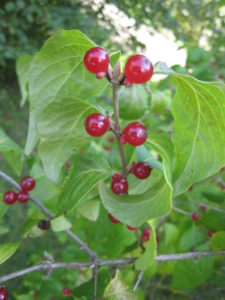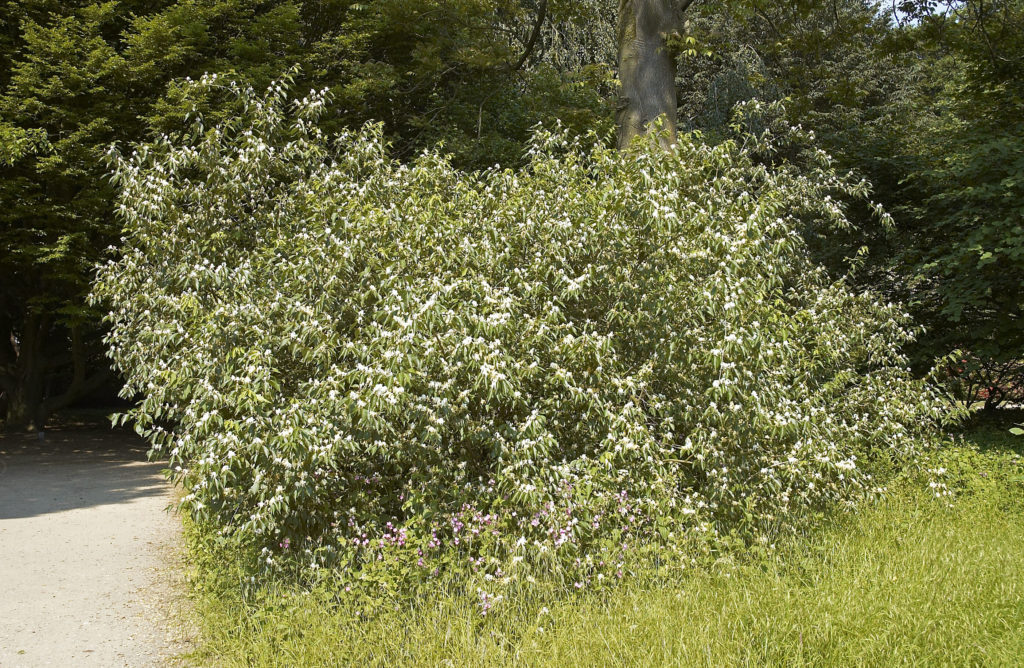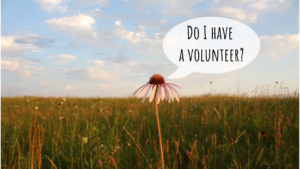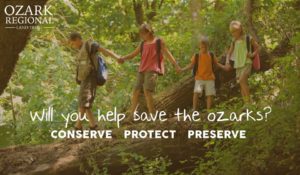
Now that the Labor Day holiday is over and students are back in school, fall seems right around the corner. Fall is one of the best times to experience the Ozarks. Mild temperatures accompanied by displays of reds, yellows, and tans change the landscape encouraging and enticing us to re-explore our favorite routes through the woods. If you’re hiking in or near an urbanized area in the coming months, you may notice that some shrubs in your favorite patch of woods still have green leaves and are speckled with berries when the rest of the forest is well on its way to dormancy for the year. These shrubs are the Bush Honeysuckle which spreads prolifically and can form impenetrable thickets in wooded and neglected urban areas.
Introduced to botanical gardens in North America as early as the late 1890s, the eastern Asian bush honeysuckle (Lonicera maackii and other Lonicera spp.) didn’t significantly invade the United States until the 1950s. The spread of bush honeysuckle is largely attributed to its popularity as an ornamental shrub in home landscaping as well as its use for erosion control and wildlife habitat (which it isn’t well suited) from the 1960s through the 1980s.
The persistent invader is now found in many woodland understories and fence rows throughout the US. Closer to home, the Northern reaches of the Ozarks near the Missouri River and urban centers have the heaviest infestations. For more information on the natural history of this impressive but menacing plant, the Missouri Botanical Garden’s webpage (Link: http://www.missouribotanicalgarden.org/gardens-gardening/gardening-in-st.-louis/invasives/bush-honeysuckle.aspx) is a good resource.

But why should you care? Although bush honeysuckle produces fragrant flowers and numerous berries it provides virtually no ecosystem services for natural areas and can inhibit many of the activities that make forests important to us; from hiking to timber harvests. Because the plant is one of the first plants to leaf-out in the spring and the last to drop its leaves in the fall, it shades out other native plants including tree seedlings. As if it didn’t have enough advantage, the leaves, roots, and berries of bush honeysuckle contain compounds that inhibit seed germination.
These competitive advantages and prolific reproduction ability lead to monocultures of shrubs that are less nutritious for wildlife than the native flora and inhibit the usual processes of the forests. Our favorite pollinating insects usually can’t find a home in honeysuckle either as many require specific native plants at some point in their life cycle. Besides the ecological impacts of our forests, large stands of bush honeysuckle are also thought to have a higher density of disease-carrying ticks than non-invaded area. And let’s admit it, it is just plain unpleasant to bushwhack through a thicket of bush honeysuckle when hiking, hunting, or just trying to get to your favorite streambank.
We can all do our part by removing bush honeysuckle from our own landscapes to prevent seed dispersion or by volunteering at a local invasive plant control day in your community. For information about control, the Missouri Department of Conservation’s webpage on bush honeysuckle control is a good starting point.
 We need your help! The Schulze Nature Preserve near Washington, MO is one of the many forests in ORLT’s service area that is in need of some serious bush honeysuckle control. Thanks to the help of the Missouri Department of Conservation, ORLT will host a honeysuckle education and volunteer workshop at Schulze Nature Preserve this fall. Anyone is welcome to come and learn about bush honeysuckle and how to effectively control it in your landscape. Please check your inbox in the coming weeks for the announcement with dates and specific information.
We need your help! The Schulze Nature Preserve near Washington, MO is one of the many forests in ORLT’s service area that is in need of some serious bush honeysuckle control. Thanks to the help of the Missouri Department of Conservation, ORLT will host a honeysuckle education and volunteer workshop at Schulze Nature Preserve this fall. Anyone is welcome to come and learn about bush honeysuckle and how to effectively control it in your landscape. Please check your inbox in the coming weeks for the announcement with dates and specific information.
What’s Menfro? Find out at Schulze Nature Preserve this Fall
 Visit Schulze Nature Preserve this fall to learn about the unique properties of Menfro soil and its importance to the region. Soil expert, Ross Braun had so much fun leading a soil workshop last spring, he is coming back to help ORLT with erosion monitoring while sharing some wisdom with our volunteers and supporters, all are welcome! Check your inbox in the coming weeks for dates and specifics.
Visit Schulze Nature Preserve this fall to learn about the unique properties of Menfro soil and its importance to the region. Soil expert, Ross Braun had so much fun leading a soil workshop last spring, he is coming back to help ORLT with erosion monitoring while sharing some wisdom with our volunteers and supporters, all are welcome! Check your inbox in the coming weeks for dates and specifics.
Don’t forget your annual membership

Land like Schulze Nature Preserve being protected FOREVER relies on your support. Your support is immensely important to not only ORLT but all of the landowners and partners who are fulfilling their wishes of protecting our beloved Ozarks. If you haven’t sent in your membership donation yet this year, please remember that more ORLT members means more family farms protected, more students connected to nature, and more generations able to enjoy the forests, streams, hollows, and hills we call home. Please click here to make a donation. Thank you for your continued support!

